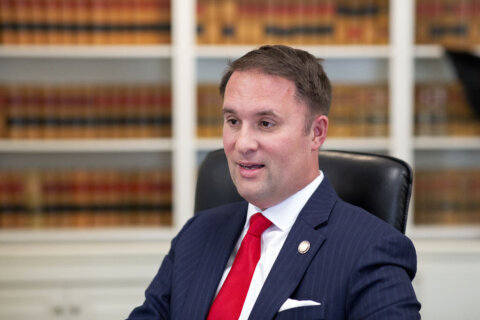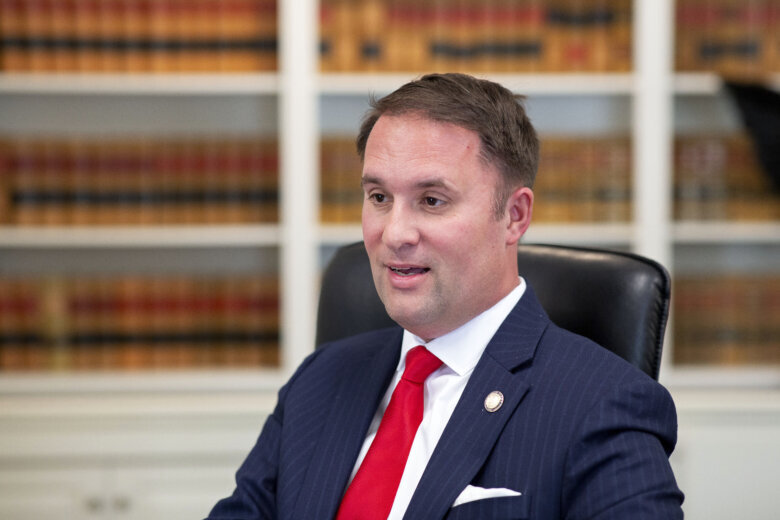This article was reprinted with permission from Virginia Mercury.

Joining 23 conservative-led states’ efforts, Virginia Attorney General Jason Miyares has signed on to legal challenges to new federal rules designed to advance emission reductions and address what scientists say is causing extreme weather events.
Miyares has challenged several rules, including the U.S. Environmental Protection Agency’s regulations for tractor trailer and passenger vehicle tailpipes, power plants and meat and poultry processors.
The crux of Miyares’ arguments in all of the legal challenges to the new emissions rules has been to combat what his office characterized as federal government overreach, which spokesperson Chloe Smith said is “a core function of state attorney general offices.”
Though Virginia follows the tailpipe emissions for passenger vehicles set by California, the different federal rules would have a “nationwide effect, including in Virginia,” on American power grids, the supply chain and consumer demand, Smith said.
President Joe Biden’s administration has rolled out the various rules as part of his agenda that has included record amounts of funding for renewable energy deployment through the Inflation Reduction Act and environmental improvement projects through the Bipartisan Infrastructure Law. The new emissions standards — and Miyares’ actions concerning them — have met with mixed reactions in Virginia from environmental groups, the trucking industry and electric utilities.
Heavy truck rule
The latest suit over the heavy truck rule is one that could apply to Virginia, since the state defaults to following the federal government for those tailpipe emissions standards while following California’s passenger car emissions rules.
Because of smog issues California faced, that state was granted an exception to the Clean Air Act to enforce stricter tailpipe emission regulations. No other state uses that exception, which prevents car manufacturers from having to make more than two different types of vehicles to meet additional standards.
Though not as stringent as California, the federal passenger car emissions rules are said to lead to greater public adoption of electric vehicles, which the federal heavy truck mirrors.
The Southern Environmental Law Center and other groups have been lauding the work from Biden — though they’d like to see previously drafted and more stringent rules around tractor trailers, or heavy trucks, get adopted — while expressing disappointment in Miyares’ actions.
“It’s very disappointing that the attorney general has joined [challenges to the rules], which will have an outsized impact on climate pollution that are not only harming the earth but also our health,” said Trip Pollard, a senior attorney with the SELC. “I can’t say I’m too surprised.”
Pollard, a leading backer of reducing car emissions, stands by the heavy truck rule because those pollutants from the transportation sector are the state and country’s largest source of greenhouse emissions that are warming the planet, leading to more frequent and severe flooding and fire events.
“There absolutely are legitimate concerns and we just need to be sure to address those concerns,” Pollard said, referencing failed attempts this past session to build out EV charging infrastructure in rural areas.
Conversely, the Virginia Trucking Association has said the new federal heavy truck rules are “unrealistic,” because of the cost to implement the changes and charging demands they say are put on truckers, and support Miyares’ pushback against them.
“We certainly appreciate their effort to stop this rule,” said Dale Bennett, president & CEO of the Virginia Trucking Association. “Let’s take a look at trying to get something that’s realistic and technology neutral.”
Bennett and the trucking industry’s opposition stems from the increased cost the rules will put on the industry that will trickle down to consumers, Bennett said, and could even lead to trucking companies buying vehicles now before needing to buy 2027 to 2032 model year trucks that will need to comply with the federal rules.
“Operationally how do you operate them if there’s no charging infrastructure?” Bennett said.
Virginia is home to a Volvo plant in Dublin that has committed to fossil fuel-free vehicles. There’s also Mack Trucks, which recently expanded in Roanoke County.
“The Volvo Group is completely aligned with EPA’s objective of speeding the transition to zero-emission vehicles (ZEVs),” said Jonathan Miller, senior vice president of public affairs for Volvo Group North America, in a statement. “Customers won’t buy ZEVs unless they’re confident they have access to charging, which neither [manufacturers] nor EPA can guarantee.”
Miller said the EPA’s new rules are “more realistic than what was originally proposed and support the agency’s pledge to consider further adjustments if necessary.”
As less than half of American respondents said in a recent Gallup poll they would purchase an electric vehicle, passenger vehicle manufacturer Ford said it is scaling back its commitments to transition fleets to electric vehicles amid sale concerns. The car maker, which recently began an ad campaign promoting options to buy gas, electric and hybrid vehicles, still filed a brief in support of the new passenger car tailpipe emissions because of the “regulatory stability” it provides.
“Even more important than the power our customers choose, is what they choose to do with that power,” said Lisa Materazzo, Ford global chief marketing officer, in a statement on its ad campaign promoting choice.
Power plant rule
The EPA’s power plant rule has a similar intent of weaning the country’s electric grid off of fossil fuel-emitting generation sources, but the VCEA directly governing the state’s grid has already set up Virginia to get there.
The new federal rule, according to the Associated Press, would create standards that require existing coal plants operating beyond 2032 to capture 90% of their emissions, or close before then. Future coal or natural gas plants would need to meet that carbon capture rate, too.
“By developing these standards in a clear, transparent, inclusive manner, EPA is cutting pollution while ensuring that power companies can make smart investments and continue to deliver reliable electricity for all Americans,” said EPA Administrator Michael S. Regan in a statement.
The rules for the coal plants could come into play for the Clover Power Station that is co-owned by Old Dominion Electric Cooperative, the electricity supplier for the state’s more rural electric cooperatives, and Dominion Energy, Virginia’s largest utility. Under the VCEA, the Clover plant is mandated to close by 2045, unless there’s a reliability concern.
If it were to stay open up until then, it would need to adopt the carbon capture technology the federal rules are requiring that industry associations are challenging because of sequestration measures being in its nascent stage. Otherwise, the 880 megawatts of electricity Clover produces, as well as several other coal plants that are already cited to come offline, would need to close, creating a reliability concern amid unprecedented energy demand.
Despite generating less and less of its potential electricity, the full output of the plant may be needed as part of a “capacity obligation” with the regional grid operator, PJM Interconnection, to supply electricity at the highest peak the grid could face at anypoint.
But whereas the tailpipe emission rules may have a more stark division between support and opposition, the power plant rules don’t have a clear for and against delineation.
“We support EPA’s authority to regulate greenhouse gas emissions under the Clean Air Act, as well as the agency’s efforts to provide paths to additional carbon reductions and cleaner resources,” said the Edison Electric Institute, the trade association for investor-owned public utilities like Dominion Energy and Appalachian Power Company, in a statement. “At the same time, we are seeking judicial review of the agency’s determination that carbon capture and storage (CCS) should be the basis for compliance with other portions of the [federal] rules.”
Old Dominion Electric Cooperative’s Kirk Johnson said in a statement: “EPA’s regulation relies on the use of carbon capture technology that is not currently commercially available, despite the Clean Air Act’s requirement that regulatory standards be achievable and based on available technologies,” Without carbon capture technology, Johnson said, “the rule will require power plants to close prematurely during a time when we expect to see unprecedented growth in the need for electricity.”
Because of the recent unveiling of the rules and ongoing litigation, Dominion spokesperson Aaron Ruby said the utility “will need time to evaluate how they might impact our existing fleet or new power stations,” which includes a natural gas plant being proposed in Chesterfield.
Teresa Hall, a spokeswoman for Appalachian Power Company, Virginia’s second largest utility that also serves West Virginia, also said carbon capture and storage is “not a viable or proven technology that can be deployed on a large scale within the timeframes required by the rule.”
Appalachian Power falls under the parent company American Electric Power, which also includes Wheeling and Kingsport power companies and had 63% and 19% of its electricity generation come from coal and natural gas, respectively, in 2023.
But Virginia has already charted itself toward an electric grid less dependent on fossil fuel through VCEA, and through the state’s previous participation in the Regional Greenhouse Initiative that required electricity producers, including utilities, to purchase allowances to emit carbon, said Walton Shepherd, Virginia Policy Director for the Natural Resources Defense Council,
“We’re already on a path to compliance,” said Shepherd, adding that technologies like battery storage are increasingly emerging as viable ways to provide electricity amid any concerns over the deployment of renewable sources, especially compared to several years ago. “The solutions are there. We have the tools.”
The lawsuit from Miyares, without an alternative solution to address the “health and welfare,” issues from emissions causing climate change for Virginia, Shepherd added, is “an insult to Virginia.”
But referencing another SCOTUS case from 2022 that arose out of West Virginia, Miyares said the EPA’s power plant rule was “overstepping its bounds,” ignoring Supreme Court guidance and “infringing upon the sovereign rights of states to manage their energy resources.”
“We are urging the Court to recognize the EPA’s illegal power-grab and ensure that any changes to our nation’s energy policies are made through the proper legislative process, not through unilateral regulatory mandates,” Miyares added.
Other action
Virginia’s attorney general has also challenged federal rules over meat and poultry waste and air quality standards, as well as some protections for solar customers. Miyares claimed wins for the withdrawal of a rule that would have allowed the public trading of corporations holding park, federal or private land with an intent to conserve it, and a settlement with Monsanto.
The additional challenges oppose regulations that would expand requirements for liquid waste produced by meat processing plants from being enacted at 171 facilities to 3,879 in the country. Details on the number of Virginia facilities the rules would apply to were not immediately available.
The EPA said the proposed rule “would reduce pollutants discharged through wastewater from [meat and poultry processing] facilities by approximately 100 million pounds per year.”
But currently, meat and poultry processing plants that aren’t discharging directly into a stream have to pre-treat their waste under a Virginia Pollution Discharge Elimination System permit before sending it to a municipal waste facility, in order to prevent the system becoming overwhelmed. That works “well the way it is,” said Hobey Bauhan, Virginia Poultry Federation president.
“We’re favorable to those who are trying to say, ‘yeah let’s take a second look,’” at the federal proposals, Bauhan said.








